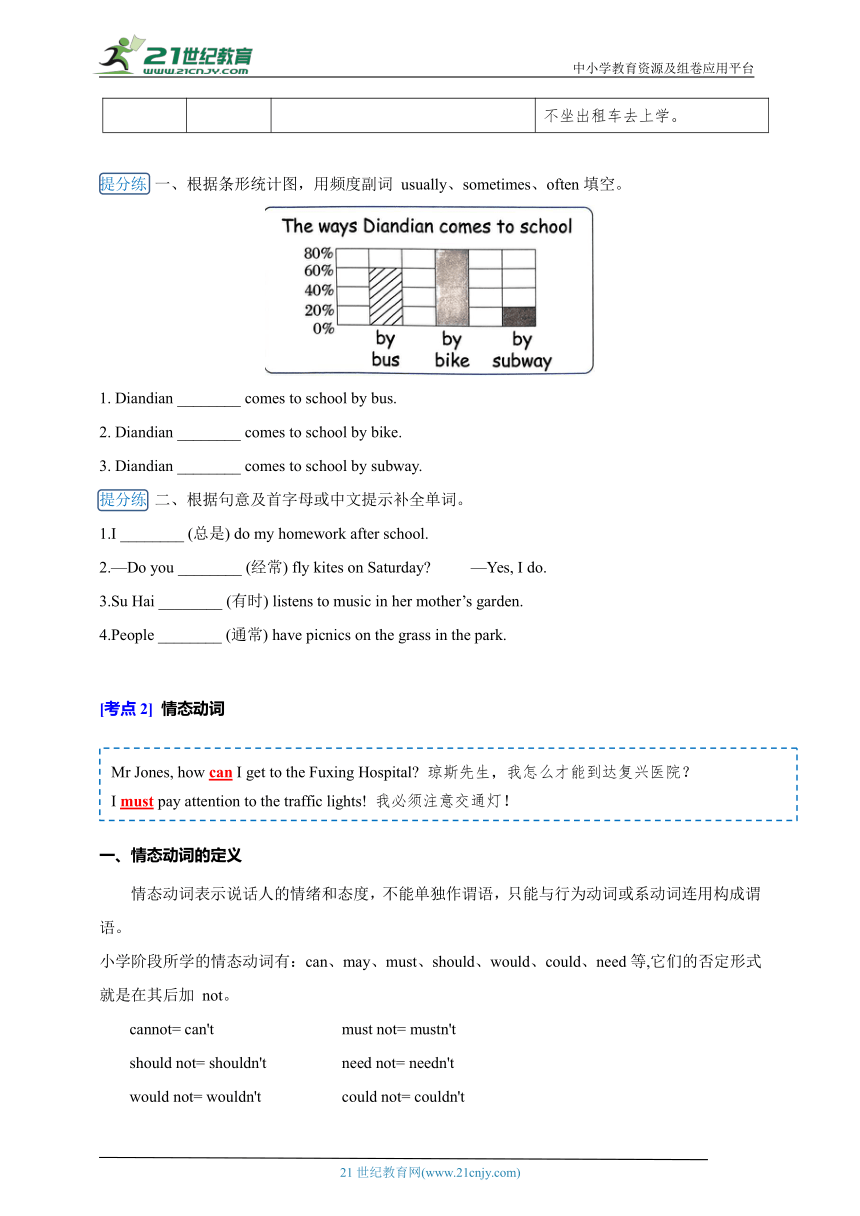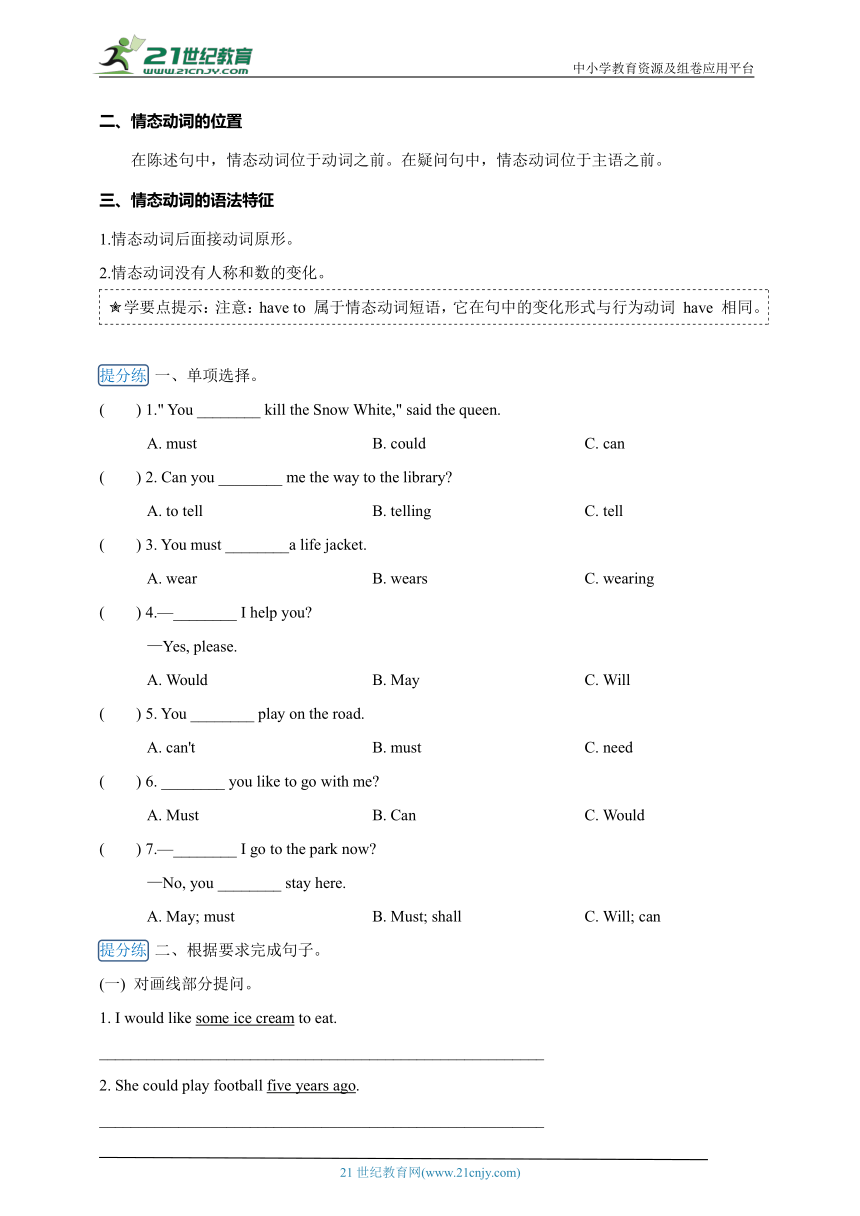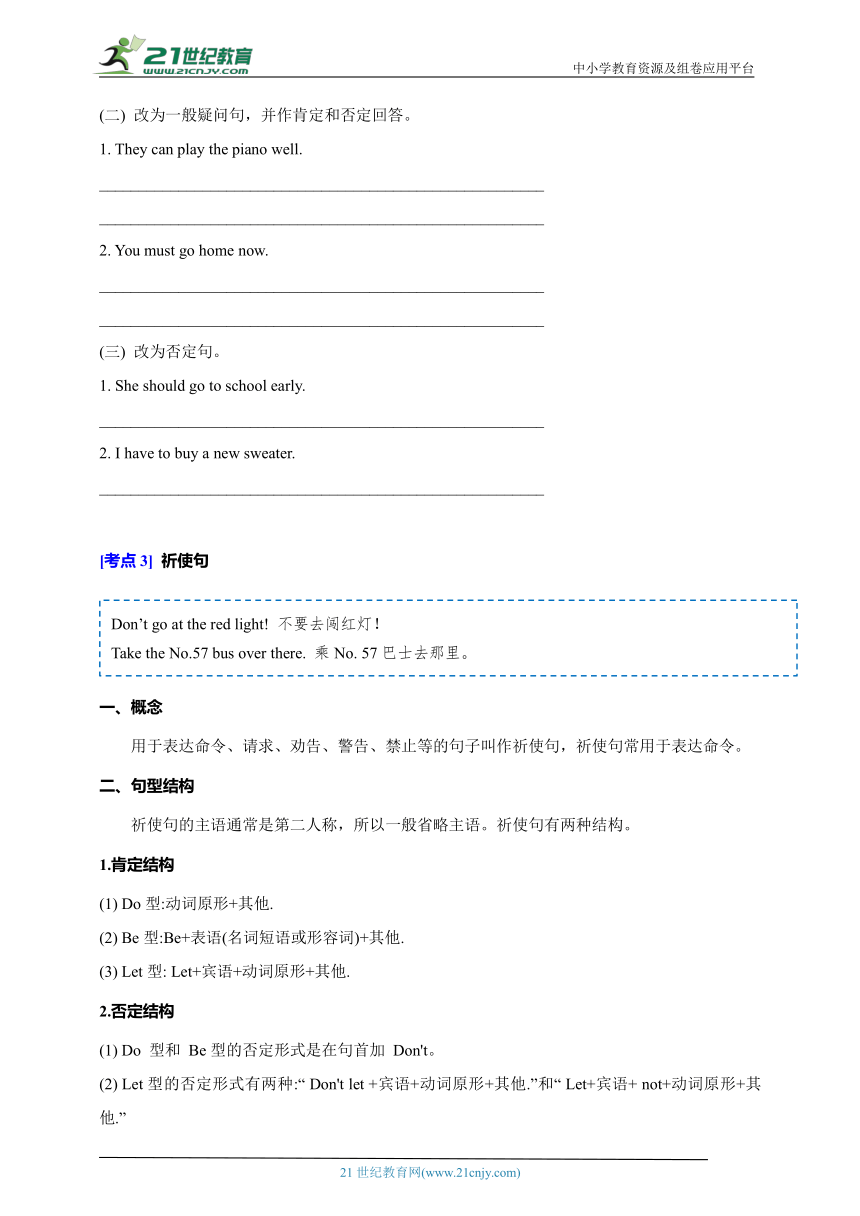Unit 2 Ways to go to school 单元复习学案(重难点精讲+巩固练习)
文档属性
| 名称 | Unit 2 Ways to go to school 单元复习学案(重难点精讲+巩固练习) |  | |
| 格式 | docx | ||
| 文件大小 | 404.2KB | ||
| 资源类型 | 试卷 | ||
| 版本资源 | 人教版(PEP) | ||
| 科目 | 英语 | ||
| 更新时间 | 2024-12-31 09:52:16 | ||
图片预览




文档简介
中小学教育资源及组卷应用平台
Unit 2 Ways to go to school
重难点讲练
[考点1] 频度副词
(
I
often
go by subway.
我经常坐地铁去。
I
usually
come on foot.
我通常是步行来。
)
一、概念
在英语中,用来表示动作发生频率高低的词被称为频度副词,如: usually, sometimes, always等。
二、在陈述句中的位置
1.放在be动词、情态动词或助动词之后。
典例:I am usually at home at weekends. 我周末通常在家。
2.放在实义动词之前。
典例:We often go to the cinema on Sundays. 我们经常在周日去看电影。
3.有时为了强调,可放在句首。
典例:Sometimes she waters flowers at weekends. 在周末,她有时浇花。
三、常见的频度副词的用法比较
频度副词 词意 含义 例句
always 一直,总是 频率最高,表示动作重复、状态持续。 I always travel by plane.我总是乘飞机旅行。
usually 通常 表示习惯性的动作或状态,很少有例外。 We usually go to school at seven in the morning. 我们通常在早上七点上学。
often 经常,时常 表示反复性的动作或状态,中间有间断。 I often go running before work.我常常在上班前跑步。
sometimes 有时 表示动作偶尔发生,间断时间较长。 She sometimes watches TV in the evening. 她有时晚上看电视。
never 从不 表示动作不会发生。 I never go to school by taxi.我从不坐出租车去上学。
提分练 一、根据条形统计图,用频度副词 usually、sometimes、often填空。
1. Diandian ________ comes to school by bus.
2. Diandian ________ comes to school by bike.
3. Diandian ________ comes to school by subway.
提分练 二、根据句意及首字母或中文提示补全单词。
1.I ________ (总是) do my homework after school.
2.—Do you ________ (经常) fly kites on Saturday —Yes, I do.
3.Su Hai ________ (有时) listens to music in her mother’s garden.
4.People ________ (通常) have picnics on the grass in the park.
[考点2] 情态动词
(
Mr Jones, how
can
I get to the Fuxing Hospital
琼斯先生,我怎么
才
能
到达
复兴医院?
I
must
pay attention to the traffic lights! 我必须注意交通灯!
)
一、情态动词的定义
情态动词表示说话人的情绪和态度,不能单独作谓语,只能与行为动词或系动词连用构成谓语。
小学阶段所学的情态动词有:can、may、must、should、would、could、need等,它们的否定形式就是在其后加 not。
cannot= can't must not= mustn't
should not= shouldn't need not= needn't
would not= wouldn't could not= couldn't
二、情态动词的位置
在陈述句中,情态动词位于动词之前。在疑问句中,情态动词位于主语之前。
三、情态动词的语法特征
1.情态动词后面接动词原形。
2.情态动词没有人称和数的变化。
学要点提示:注意:have to 属于情态动词短语,它在句中的变化形式与行为动词 have 相同。
提分练 一、单项选择。
( ) 1." You ________ kill the Snow White," said the queen.
A. must B. could C. can
( ) 2. Can you ________ me the way to the library
A. to tell B. telling C. tell
( ) 3. You must ________a life jacket.
A. wear B. wears C. wearing
( ) 4.—________ I help you
—Yes, please.
A. Would B. May C. Will
( ) 5. You ________ play on the road.
A. can't B. must C. need
( ) 6. ________ you like to go with me
A. Must B. Can C. Would
( ) 7.—________ I go to the park now
—No, you ________ stay here.
A. May; must B. Must; shall C. Will; can
提分练 二、根据要求完成句子。
(一) 对画线部分提问。
1. I would like some ice cream to eat.
________________________________________________________
2. She could play football five years ago.
________________________________________________________
(二) 改为一般疑问句,并作肯定和否定回答。
1. They can play the piano well.
________________________________________________________
________________________________________________________
2. You must go home now.
________________________________________________________
________________________________________________________
(三) 改为否定句。
1. She should go to school early.
________________________________________________________
2. I have to buy a new sweater.
________________________________________________________
[考点3] 祈使句
(
Don
’
t go at the red light!
不要去闯红灯!
Take the No.57 bus over there. 乘No. 57巴士去那里。
)
一、概念
用于表达命令、请求、劝告、警告、禁止等的句子叫作祈使句,祈使句常用于表达命令。
二、句型结构
祈使句的主语通常是第二人称,所以一般省略主语。祈使句有两种结构。
1.肯定结构
(1) Do型:动词原形+其他.
(2) Be型:Be+表语(名词短语或形容词)+其他.
(3) Let型: Let+宾语+动词原形+其他.
2.否定结构
(1) Do 型和 Be型的否定形式是在句首加 Don't。
(2) Let型的否定形式有两种:“ Don't let +宾语+动词原形+其他.”和“ Let+宾语+ not+动词原形+其他.”
(3)有些以 No开头,用来引导表示禁止的祈使句。
口诀: 祈使句无主语,主语 you常省去; 动词原形当谓语,句首加 Don't变否定; 朗读应当用降调,句末句点感叹号。
提分练 一、用所给词的适当形式填空。
1. ________( not talk) to your mum like that!
2.—Let ________(I) help you!
—Thank you.
3.—________( go) this way, please.
—OK.
4. ________( be) quiet, please.
5. Let's ________( say) something about it.
6. Let ________( they) go to the shop.
7. Let her ________( not eat) the ice cream.
8. ________( not be) late for school again.
9. ________( not swim) in the river.
10. Tell him ________( not come) to the classroom.
提分练 二、单项选择。
( ) 1. ________ me an email after you arrive in Beijing.
A. To send B. Send C. Sends
( )2. ________, or we' ll be late for the bus.
A. Don't worry B. Never mind C. Hurry up
( ) 3. Peter, ________ the car! An old man is waiting to cross the road.
A. stops B. stop C. don't stop
( ) 4. ________ friendly and helpful to others, and the world will be nicer.
A. Be B. Being C. To be
( ) 5.—Don't take photos here, please.
—________
A. No way. B. Sorry,I won't. C. Here you are.
提分练 三、将下列句子改为否定句。
1. Let's go to the park.
Let's ________________________________________.
2. Play on the playground.
____________________________________________
3. Watch your phone on the road.
____________________________________________
4. Watch TV too much.
____________________________________________
5. Let him go.
____________________________________________
重难点强化练习
六、单项选择。(5分)
( ) 1. We ________ pay attention to the traffic lights.
A. can B. must C. can’t
( )2. Which of the following traffic signs is“ Don't go straight”
( ) 3. The bookstore is far from here. Let’s ________a bus over there.
A. take B. by C. on
( ) 4. I usually ________. That's good exercise.
A. walk to school B.come to school by car C.come to school by subway
( )5. Which is not right
A. wear a life jacket B. at a red light C. lots of pictures
二、用所给单词的正确形式填空。(10分)
1. It ________( snow) a lot in Harbin in winter.
2. Don't ________( drive) too fast.
3.—How does your father ________( go ) to work —By bike.
4. Stop and ________( wait) at a red light.
5. You must ________( wear) a life jacket when you go to school by ferry.
三、补全对话。(有两个多余项) (10分)
( Diandian and Longlong are walking on the street.)
Diandian: Wait! 1. ________
Longlong: Oh, no. I didn't pay attention to the traffic
lights.
(
A.
I'll
go
there
by
bus.
B.
There
will
be
a
book
signing
at
the
library
tomorrow.
C.
How
can
we
get
there
D.
It's
next
to
the
science
museum.
E.
The
traffic
light
is
red!
F.
The
light
is
green.
G.
How
do
you
get
there
) Diandian: Be careful next time.
Longlong: OK.2. ________ Do you want to go there
Diandian: Yes, I do. But where is it
Longlong: It's on Fuqiang Road. 3. ________
Diandian: Oh, I know.4. ________
Longlong: By bike. It's not far from my home. How
about you
Diandian: 5. ________
四、根据表格信息,判断下列句子正(T)误(F) 。(10分)
Diandian √ √ √ √ √
Congcong √ √ √ √ √
Mengmeng √ √ √ √ √
Tongtong √ √ √ √ √
( ) 1. Diandian usually goes to school by subway.
( ) 2. Congcong always walks to school.
( ) 3. Mengmeng often goes to school by bus.
( ) 4. Tongtong sometimes goes to school by car.
( ) 5. Both Mengmeng and Tongtong can ride a bike.
参考答案
(1) 频度副词
一、1. often 2. usually 3. sometimes
解析:本题考查频度副词的使用,仔细观察条形统计图,再从题干中找到对应的交通方式,即可得出答案。
二、1.always 2.often 3.sometimes 4.usually
(2) 情态动词
一、1. A解析:根据句意可知“你必须杀掉白雪公主。”故选 A。
2. C 解析: can 是情态动词,后面的动词用原形,故选 C。
3. A 解析: must后接动词原形, 故选 A。
4. B 解析:为别人提供帮助, 用 may或 can,故选 B。
5. A解析:根据常识可知,不能在马路上玩耍,故选 A。
6. C 解析:“ would like”意为“想要”。
7. A 解析: may意为“可以”, 用于提出请求;must意为“必须”,用于表达命令。
二、(一) 1. What would you like to eat
2. When could she play football
(二) 1.—Can they play the piano well
—Yes, they can. / No, they can't.
2.—Must I go home now
—Yes, you must./ No, you needn't.
(三) 1. She shouldn't go to school early.
2. I don't have to buy a new sweater.
解析:含有“ have to”的句子, 按照 have 作为行为动词的情况进行句型转换,故否定句在 have 前面加 don’t。
(3) 祈使句
一、1. Don’t talk 解析: Do型祈使句变否定句, 直接在句首加 Don't。
2.me 解析:let后面跟人称代词的宾格形式。I的宾格形式是 me。
3. Go 解析:在祈使句中,句首的动词用原形。
4. Be 解析:在祈使句中,句首的动词用原形; be动词的原形还是 be。
5. say 解析: Let’s 后接动词原形。
6. them 解析:动词后接人称代词的宾格形式。
7. not eat 8. Don't be 9. Don't swim
10. not to come 解析:“tell sb. not to do sth.”意为“告诉某人不要做某事”。
二、1. B解析:祈使句以动词原形开头。
2. C
3. B 解析:“stop the car”意为“停车”。
4. A
5. B 解析:“Sorry,I won’t.”意为“对不起, 我不会了。”。
三、1. not go to the park
2. Don't play on the playground.
3. Don't watch your phone on the road.
4. Don't watch TV too much.可知,答语为表示将来的时间,故选B。
5. Don't let him go.
重难点强化练习答案
一、1. B 2. A 3. A 4. A 5. B
二、1. snows
2. drive 解析:该句为祈使句的否定形式,don't后用动词原形。
3. go 4. wait 5. wear
三、1. E 2. B 3. D 4. G 5. A
四、1. T 2. T 3. F 4. F 5. T
21世纪教育网(www.21cnjy.com)
Unit 2 Ways to go to school
重难点讲练
[考点1] 频度副词
(
I
often
go by subway.
我经常坐地铁去。
I
usually
come on foot.
我通常是步行来。
)
一、概念
在英语中,用来表示动作发生频率高低的词被称为频度副词,如: usually, sometimes, always等。
二、在陈述句中的位置
1.放在be动词、情态动词或助动词之后。
典例:I am usually at home at weekends. 我周末通常在家。
2.放在实义动词之前。
典例:We often go to the cinema on Sundays. 我们经常在周日去看电影。
3.有时为了强调,可放在句首。
典例:Sometimes she waters flowers at weekends. 在周末,她有时浇花。
三、常见的频度副词的用法比较
频度副词 词意 含义 例句
always 一直,总是 频率最高,表示动作重复、状态持续。 I always travel by plane.我总是乘飞机旅行。
usually 通常 表示习惯性的动作或状态,很少有例外。 We usually go to school at seven in the morning. 我们通常在早上七点上学。
often 经常,时常 表示反复性的动作或状态,中间有间断。 I often go running before work.我常常在上班前跑步。
sometimes 有时 表示动作偶尔发生,间断时间较长。 She sometimes watches TV in the evening. 她有时晚上看电视。
never 从不 表示动作不会发生。 I never go to school by taxi.我从不坐出租车去上学。
提分练 一、根据条形统计图,用频度副词 usually、sometimes、often填空。
1. Diandian ________ comes to school by bus.
2. Diandian ________ comes to school by bike.
3. Diandian ________ comes to school by subway.
提分练 二、根据句意及首字母或中文提示补全单词。
1.I ________ (总是) do my homework after school.
2.—Do you ________ (经常) fly kites on Saturday —Yes, I do.
3.Su Hai ________ (有时) listens to music in her mother’s garden.
4.People ________ (通常) have picnics on the grass in the park.
[考点2] 情态动词
(
Mr Jones, how
can
I get to the Fuxing Hospital
琼斯先生,我怎么
才
能
到达
复兴医院?
I
must
pay attention to the traffic lights! 我必须注意交通灯!
)
一、情态动词的定义
情态动词表示说话人的情绪和态度,不能单独作谓语,只能与行为动词或系动词连用构成谓语。
小学阶段所学的情态动词有:can、may、must、should、would、could、need等,它们的否定形式就是在其后加 not。
cannot= can't must not= mustn't
should not= shouldn't need not= needn't
would not= wouldn't could not= couldn't
二、情态动词的位置
在陈述句中,情态动词位于动词之前。在疑问句中,情态动词位于主语之前。
三、情态动词的语法特征
1.情态动词后面接动词原形。
2.情态动词没有人称和数的变化。
学要点提示:注意:have to 属于情态动词短语,它在句中的变化形式与行为动词 have 相同。
提分练 一、单项选择。
( ) 1." You ________ kill the Snow White," said the queen.
A. must B. could C. can
( ) 2. Can you ________ me the way to the library
A. to tell B. telling C. tell
( ) 3. You must ________a life jacket.
A. wear B. wears C. wearing
( ) 4.—________ I help you
—Yes, please.
A. Would B. May C. Will
( ) 5. You ________ play on the road.
A. can't B. must C. need
( ) 6. ________ you like to go with me
A. Must B. Can C. Would
( ) 7.—________ I go to the park now
—No, you ________ stay here.
A. May; must B. Must; shall C. Will; can
提分练 二、根据要求完成句子。
(一) 对画线部分提问。
1. I would like some ice cream to eat.
________________________________________________________
2. She could play football five years ago.
________________________________________________________
(二) 改为一般疑问句,并作肯定和否定回答。
1. They can play the piano well.
________________________________________________________
________________________________________________________
2. You must go home now.
________________________________________________________
________________________________________________________
(三) 改为否定句。
1. She should go to school early.
________________________________________________________
2. I have to buy a new sweater.
________________________________________________________
[考点3] 祈使句
(
Don
’
t go at the red light!
不要去闯红灯!
Take the No.57 bus over there. 乘No. 57巴士去那里。
)
一、概念
用于表达命令、请求、劝告、警告、禁止等的句子叫作祈使句,祈使句常用于表达命令。
二、句型结构
祈使句的主语通常是第二人称,所以一般省略主语。祈使句有两种结构。
1.肯定结构
(1) Do型:动词原形+其他.
(2) Be型:Be+表语(名词短语或形容词)+其他.
(3) Let型: Let+宾语+动词原形+其他.
2.否定结构
(1) Do 型和 Be型的否定形式是在句首加 Don't。
(2) Let型的否定形式有两种:“ Don't let +宾语+动词原形+其他.”和“ Let+宾语+ not+动词原形+其他.”
(3)有些以 No开头,用来引导表示禁止的祈使句。
口诀: 祈使句无主语,主语 you常省去; 动词原形当谓语,句首加 Don't变否定; 朗读应当用降调,句末句点感叹号。
提分练 一、用所给词的适当形式填空。
1. ________( not talk) to your mum like that!
2.—Let ________(I) help you!
—Thank you.
3.—________( go) this way, please.
—OK.
4. ________( be) quiet, please.
5. Let's ________( say) something about it.
6. Let ________( they) go to the shop.
7. Let her ________( not eat) the ice cream.
8. ________( not be) late for school again.
9. ________( not swim) in the river.
10. Tell him ________( not come) to the classroom.
提分练 二、单项选择。
( ) 1. ________ me an email after you arrive in Beijing.
A. To send B. Send C. Sends
( )2. ________, or we' ll be late for the bus.
A. Don't worry B. Never mind C. Hurry up
( ) 3. Peter, ________ the car! An old man is waiting to cross the road.
A. stops B. stop C. don't stop
( ) 4. ________ friendly and helpful to others, and the world will be nicer.
A. Be B. Being C. To be
( ) 5.—Don't take photos here, please.
—________
A. No way. B. Sorry,I won't. C. Here you are.
提分练 三、将下列句子改为否定句。
1. Let's go to the park.
Let's ________________________________________.
2. Play on the playground.
____________________________________________
3. Watch your phone on the road.
____________________________________________
4. Watch TV too much.
____________________________________________
5. Let him go.
____________________________________________
重难点强化练习
六、单项选择。(5分)
( ) 1. We ________ pay attention to the traffic lights.
A. can B. must C. can’t
( )2. Which of the following traffic signs is“ Don't go straight”
( ) 3. The bookstore is far from here. Let’s ________a bus over there.
A. take B. by C. on
( ) 4. I usually ________. That's good exercise.
A. walk to school B.come to school by car C.come to school by subway
( )5. Which is not right
A. wear a life jacket B. at a red light C. lots of pictures
二、用所给单词的正确形式填空。(10分)
1. It ________( snow) a lot in Harbin in winter.
2. Don't ________( drive) too fast.
3.—How does your father ________( go ) to work —By bike.
4. Stop and ________( wait) at a red light.
5. You must ________( wear) a life jacket when you go to school by ferry.
三、补全对话。(有两个多余项) (10分)
( Diandian and Longlong are walking on the street.)
Diandian: Wait! 1. ________
Longlong: Oh, no. I didn't pay attention to the traffic
lights.
(
A.
I'll
go
there
by
bus.
B.
There
will
be
a
book
signing
at
the
library
tomorrow.
C.
How
can
we
get
there
D.
It's
next
to
the
science
museum.
E.
The
traffic
light
is
red!
F.
The
light
is
green.
G.
How
do
you
get
there
) Diandian: Be careful next time.
Longlong: OK.2. ________ Do you want to go there
Diandian: Yes, I do. But where is it
Longlong: It's on Fuqiang Road. 3. ________
Diandian: Oh, I know.4. ________
Longlong: By bike. It's not far from my home. How
about you
Diandian: 5. ________
四、根据表格信息,判断下列句子正(T)误(F) 。(10分)
Diandian √ √ √ √ √
Congcong √ √ √ √ √
Mengmeng √ √ √ √ √
Tongtong √ √ √ √ √
( ) 1. Diandian usually goes to school by subway.
( ) 2. Congcong always walks to school.
( ) 3. Mengmeng often goes to school by bus.
( ) 4. Tongtong sometimes goes to school by car.
( ) 5. Both Mengmeng and Tongtong can ride a bike.
参考答案
(1) 频度副词
一、1. often 2. usually 3. sometimes
解析:本题考查频度副词的使用,仔细观察条形统计图,再从题干中找到对应的交通方式,即可得出答案。
二、1.always 2.often 3.sometimes 4.usually
(2) 情态动词
一、1. A解析:根据句意可知“你必须杀掉白雪公主。”故选 A。
2. C 解析: can 是情态动词,后面的动词用原形,故选 C。
3. A 解析: must后接动词原形, 故选 A。
4. B 解析:为别人提供帮助, 用 may或 can,故选 B。
5. A解析:根据常识可知,不能在马路上玩耍,故选 A。
6. C 解析:“ would like”意为“想要”。
7. A 解析: may意为“可以”, 用于提出请求;must意为“必须”,用于表达命令。
二、(一) 1. What would you like to eat
2. When could she play football
(二) 1.—Can they play the piano well
—Yes, they can. / No, they can't.
2.—Must I go home now
—Yes, you must./ No, you needn't.
(三) 1. She shouldn't go to school early.
2. I don't have to buy a new sweater.
解析:含有“ have to”的句子, 按照 have 作为行为动词的情况进行句型转换,故否定句在 have 前面加 don’t。
(3) 祈使句
一、1. Don’t talk 解析: Do型祈使句变否定句, 直接在句首加 Don't。
2.me 解析:let后面跟人称代词的宾格形式。I的宾格形式是 me。
3. Go 解析:在祈使句中,句首的动词用原形。
4. Be 解析:在祈使句中,句首的动词用原形; be动词的原形还是 be。
5. say 解析: Let’s 后接动词原形。
6. them 解析:动词后接人称代词的宾格形式。
7. not eat 8. Don't be 9. Don't swim
10. not to come 解析:“tell sb. not to do sth.”意为“告诉某人不要做某事”。
二、1. B解析:祈使句以动词原形开头。
2. C
3. B 解析:“stop the car”意为“停车”。
4. A
5. B 解析:“Sorry,I won’t.”意为“对不起, 我不会了。”。
三、1. not go to the park
2. Don't play on the playground.
3. Don't watch your phone on the road.
4. Don't watch TV too much.可知,答语为表示将来的时间,故选B。
5. Don't let him go.
重难点强化练习答案
一、1. B 2. A 3. A 4. A 5. B
二、1. snows
2. drive 解析:该句为祈使句的否定形式,don't后用动词原形。
3. go 4. wait 5. wear
三、1. E 2. B 3. D 4. G 5. A
四、1. T 2. T 3. F 4. F 5. T
21世纪教育网(www.21cnjy.com)
同课章节目录
